
Gujarat, governed uninterrupted by the BJP for 22 years, votes on December 9 and 14
- Surat is home to diamond and textile industry, traders upset with GST
- Surat, BJP stronghold, is also dominated by Patels, who want reservation
- Surat's Patels also influence Saurashtra, which elects 50 MLAs
Did our AI summary help?
Let us know.
Surat, Gujarat:
As Prime Minister Narendra Modi pushed his campaign for Gujarat into top gear on Monday, he placed Surat high on his itinerary. Before it votes on December 9, he is expected to revisit the city next week.
As the commercial capital of Gujarat, Surat has always been high-maintenance for politicians. But in this election, when it is seen as reviewing its steadfast loyalty to the BJP, its political intensity has peaked.
The second-largest city in the PM's home state after Ahmedabad, embodies core Gujarati values - of trade and enterprise, of immigrants elbowing their way in to claim a stake of the bustling commerce, of staunch Hinduism, of diamonds and textiles creating dramatic fortunes like the tycoon who three years ago gifted his employees with apartments and cars for Diwali.
Since 2002, the BJP has won every single one of the 16 assembly seats in the Surat district. But in the 2015 municipal election, the Congress more than doubled its seats (the BJP though won the corporation easily).
It wasn't the Congress that did the hard work. The corporation in Surat was elected months after Hardik Patel, then just 22, delivered impassioned speeches at public parks and stadiums packed with other young Patels like himself. He had one demand - the community must benefit from affirmative action policies. Prime Minister Modi and his famous Gujarat Model of Development, he alleged, had not created jobs. When other castes were guaranteed government positions and seats in colleges, why not the Patels, who make up 14% of Gujarat's population, he asked.
 This agenda was disclosed by him at his first-ever rally in August 2015 - in Surat. More than five lakh people were present. A nerve had been struck very hard.
This agenda was disclosed by him at his first-ever rally in August 2015 - in Surat. More than five lakh people were present. A nerve had been struck very hard.
The Surat corporation results in December that year proved the Patels were turning away from the BJP. And that was well before PM Modi dropped demonetization on the country, which was succeed by another mega-reform, the new national sales tax or GST.
The resulting cash crunch and dip in sales further angered the Patels of Surat, who control nearly 70% of its diamond and textile business and directly influence results in five of its 12 assembly seats. That is why the PM chose Surat for his first road show in Gujarat in April with gestures that acknowledged the financial and political clout of the city's Patedars - inaugurating a state-of-the-art hospital in the Patel stronghold of Katargam and a diamond-manufacturing unit.
On Monday, the PM was back in Surat with his now-familiar rhetoric - targeting Rahul Gandhi and the Congress Party for hurting Gujarati asmita or pride. "Will you let them insult a son of Gujarat?" he asked. But there was no reference to the sore points of either the GST or the Patel call for reservation. Instead, it was Finance Minister Arun Jaitley and BJP chief Amit Shah who tried to assuage the Patels at meetings this month with representatives of the textile and diamond industry.
 The Congress has also accorded Surat VIP status, with Mr Gandhi pointedly choosing it as his destination on November 8, the first anniversary of Prime Minister Modi's shock decision to ban high-value notes. The Congress leader met with workers and owners of textile and diamond units and pledged that if elected, the Congress would make significant changes to the GST.
The Congress has also accorded Surat VIP status, with Mr Gandhi pointedly choosing it as his destination on November 8, the first anniversary of Prime Minister Modi's shock decision to ban high-value notes. The Congress leader met with workers and owners of textile and diamond units and pledged that if elected, the Congress would make significant changes to the GST.
After months of talks, it was only last week that Hardik Patel formally committed his support to the Congress, declaring that its offer for reservation for Patels is acceptable.
Early this month, Mr Gandhi addressed a rally in the Patel-dominated Varachcha area of the Surat district which erupted as a hot spot during 2015's quota agitation with violent clashes that lasted nearly ten days. Varachcha has nearly 2 lakh voters; more than three fourths are Patels; no candidate can win from here without their support.
Satyakam Joshi, a political analyst in Surat, explains the real danger of Hardik Patel - the likelihood that he could split the vote in large precincts like this. Mr Joshi divides Varachcha's population into three categories. The big businessmen who own large diamond and textile units and remain hardcore Modi supporters; a section had initially funded Hardik Patel's agitation but was persuaded or pressured to track back to the BJP. The middle class made up of professionals, real estate developers and owners of mid-size businesses who have been hit hard by GST and the notes ban, but may find it difficult to break inherited ideological ties with the ruling party. And the younger generation, sons of diamond cutters and textile labourers, who are educated; "they don't want to work as daily wagers but can't find jobs which are socially more acceptable, and it is they who can dent the BJPs stranglehold on Surat," believes Mr Joshi.
 Ghanshyam is a 26-year-old graduate who works as a diamond cutter, like his father before him. "My family came here from Saurashtra in the mid-1960s after successive droughts and shortage of water devastated our fields and like many others, they entered either the textile or diamond industry. My father struggled hard to give me an education, but I could not find any other employment," he said as he prepped to bike to work.
Ghanshyam is a 26-year-old graduate who works as a diamond cutter, like his father before him. "My family came here from Saurashtra in the mid-1960s after successive droughts and shortage of water devastated our fields and like many others, they entered either the textile or diamond industry. My father struggled hard to give me an education, but I could not find any other employment," he said as he prepped to bike to work.
Ghanshyam says he is a die-hard Hardik Patel supporter and will therefore vote for the Congress. "I joined PAAS (Hardik Patel's outfit) in protest against Narendra Modi's Gujarat model of development which focused on big industry for nearly two decades and failed to create jobs for young people like me." But Ghanshyam says he is not pro-reservation either. "There are too many of us wanting a piece of the same quota pie. All politicians, even Hardik, will have to look beyond it and come up with new ideas. But how will we know what he is capable of unless we give him and Rahul Gandhi a chance?"
Not all of Hardik Patel's young supporters in Varachcha are as reasonable or patient as Ghanshyam. Many have put up hoardings in their neighbourhoods banning the entry of local BJP leaders; a few that dared to cross the line were chased away by angry crowds.
 In October, the BJP tried to make peace with the Patels by ordering the cancellation of cases filed against more than 600 Patidar youth during the reservation protests in 2015. While PAAS has dismissed it as an empty gesture, CR Patil, the BJP law-maker from Navsari who is also in charge of the party's election campaign in Surat district, claims the outreach has worked. Mr Patil is a trusted aide in charge of all development work in PM Modi's constituency of Varanasi; it is why he has been tasked with handling Surat.
In October, the BJP tried to make peace with the Patels by ordering the cancellation of cases filed against more than 600 Patidar youth during the reservation protests in 2015. While PAAS has dismissed it as an empty gesture, CR Patil, the BJP law-maker from Navsari who is also in charge of the party's election campaign in Surat district, claims the outreach has worked. Mr Patil is a trusted aide in charge of all development work in PM Modi's constituency of Varanasi; it is why he has been tasked with handling Surat.
"My information is based on the feedback I am receiving from the call centres set up in each assembly segment," he told NDTV. "Each centre is manned by 50 activists who have been contacting voters over the phone. Anyone who is unavailable has received a house visit. So we have a very good idea of what is happening on the ground." The big picture, he says, is a happy one for the BJP in Surat.
 But it's not just the Patels of Surat who appear to be split between Hardik Patel (and by association, the Congress) and the BJP. The city's large non-Gujarati population, mainly textile traders and workers from UP, Bihar and Rajasthan who control the power-loom industry, also seem divided over supporting the ruling party.
But it's not just the Patels of Surat who appear to be split between Hardik Patel (and by association, the Congress) and the BJP. The city's large non-Gujarati population, mainly textile traders and workers from UP, Bihar and Rajasthan who control the power-loom industry, also seem divided over supporting the ruling party.
These migrants comprise nearly 26% of Surat's 44.26 lakh population and are as frustrated as the Patels by demonetisation and GST. Staunch BJP loyalists, in 2014, they printed thousands of sarees with the slogan "Ab ki baar, Modi Sarkar" and sent them to different cities. The following year, more than a lakh sarees were delivered to Bihar printed with the slogan "Sabka saath, sabka vikaas".
"Our business is down by 60%, and the BJP will pay the price for it," says Tarachand Kasat, who heads the main association of textile traders and has just abandoned the BJP, which he joined in 1982, for the Congress.
It is to placate this constituency of immigrants like him that Uttar Pradesh Chief Minister Yogi Adityanath was sent to Surat, where he is exercising aggressive Hindutva to consolidate the Hindu vote. At one rally, he alleged that Mr Gandhi "sat in the Kashi Vishwanath temple like he was offering namaz." At another, he compared Sardar Patel with Lord Ram who united the entire country.
 Apart from its own stature as the money-maker of Gujarat, Surat's political choice influences Saurashtra, the large western region from where many Patels migrated. They still have strong family ties and business interests in the region. Saurashtra elects as many as 50 law-makers, so its choices, partially dictated by Surat, are jet fuel for a party.
Apart from its own stature as the money-maker of Gujarat, Surat's political choice influences Saurashtra, the large western region from where many Patels migrated. They still have strong family ties and business interests in the region. Saurashtra elects as many as 50 law-makers, so its choices, partially dictated by Surat, are jet fuel for a party.
In the district panchayat elections held after Hardik Patel's 2015 campaign, the BJP won only one of 11 panchayats across Saurashtra. The message had been received from Surat. It is this full-bodied swing at it that the BJP is working overtime to reverse. Hardik Patel may not blow a large hole through the BJP's count in either Surat or Saurashtra. But he is unlikely to be a factor that can be cornered by a defeat.
As the commercial capital of Gujarat, Surat has always been high-maintenance for politicians. But in this election, when it is seen as reviewing its steadfast loyalty to the BJP, its political intensity has peaked.
The second-largest city in the PM's home state after Ahmedabad, embodies core Gujarati values - of trade and enterprise, of immigrants elbowing their way in to claim a stake of the bustling commerce, of staunch Hinduism, of diamonds and textiles creating dramatic fortunes like the tycoon who three years ago gifted his employees with apartments and cars for Diwali.
Since 2002, the BJP has won every single one of the 16 assembly seats in the Surat district. But in the 2015 municipal election, the Congress more than doubled its seats (the BJP though won the corporation easily).
It wasn't the Congress that did the hard work. The corporation in Surat was elected months after Hardik Patel, then just 22, delivered impassioned speeches at public parks and stadiums packed with other young Patels like himself. He had one demand - the community must benefit from affirmative action policies. Prime Minister Modi and his famous Gujarat Model of Development, he alleged, had not created jobs. When other castes were guaranteed government positions and seats in colleges, why not the Patels, who make up 14% of Gujarat's population, he asked.
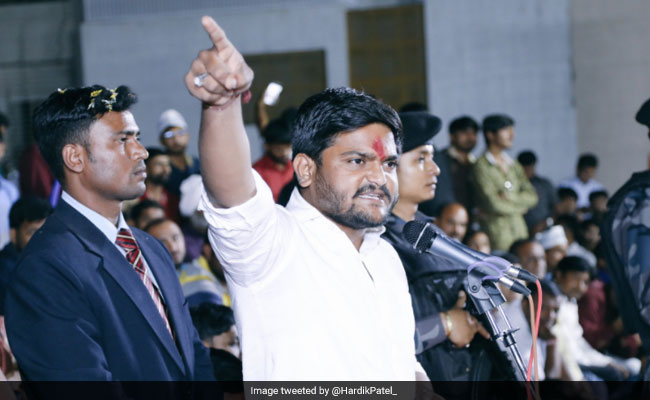
24-year-old Hardik Patel is the face of the Patidar agitation in Gujarat
The Surat corporation results in December that year proved the Patels were turning away from the BJP. And that was well before PM Modi dropped demonetization on the country, which was succeed by another mega-reform, the new national sales tax or GST.
The resulting cash crunch and dip in sales further angered the Patels of Surat, who control nearly 70% of its diamond and textile business and directly influence results in five of its 12 assembly seats. That is why the PM chose Surat for his first road show in Gujarat in April with gestures that acknowledged the financial and political clout of the city's Patedars - inaugurating a state-of-the-art hospital in the Patel stronghold of Katargam and a diamond-manufacturing unit.
On Monday, the PM was back in Surat with his now-familiar rhetoric - targeting Rahul Gandhi and the Congress Party for hurting Gujarati asmita or pride. "Will you let them insult a son of Gujarat?" he asked. But there was no reference to the sore points of either the GST or the Patel call for reservation. Instead, it was Finance Minister Arun Jaitley and BJP chief Amit Shah who tried to assuage the Patels at meetings this month with representatives of the textile and diamond industry.
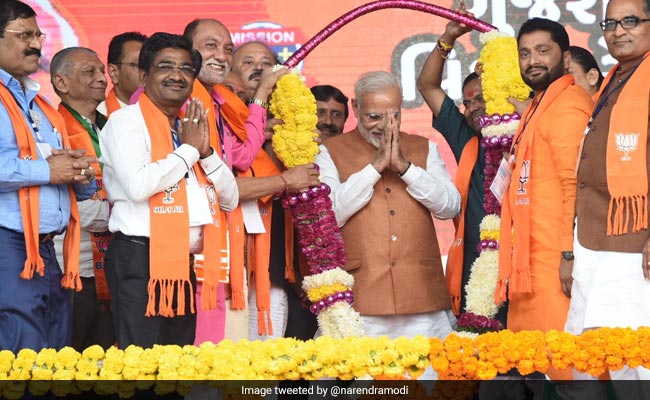
Prime Minister Narendra Modi at a rally in Surat, Gujarat
After months of talks, it was only last week that Hardik Patel formally committed his support to the Congress, declaring that its offer for reservation for Patels is acceptable.
Early this month, Mr Gandhi addressed a rally in the Patel-dominated Varachcha area of the Surat district which erupted as a hot spot during 2015's quota agitation with violent clashes that lasted nearly ten days. Varachcha has nearly 2 lakh voters; more than three fourths are Patels; no candidate can win from here without their support.
Satyakam Joshi, a political analyst in Surat, explains the real danger of Hardik Patel - the likelihood that he could split the vote in large precincts like this. Mr Joshi divides Varachcha's population into three categories. The big businessmen who own large diamond and textile units and remain hardcore Modi supporters; a section had initially funded Hardik Patel's agitation but was persuaded or pressured to track back to the BJP. The middle class made up of professionals, real estate developers and owners of mid-size businesses who have been hit hard by GST and the notes ban, but may find it difficult to break inherited ideological ties with the ruling party. And the younger generation, sons of diamond cutters and textile labourers, who are educated; "they don't want to work as daily wagers but can't find jobs which are socially more acceptable, and it is they who can dent the BJPs stranglehold on Surat," believes Mr Joshi.
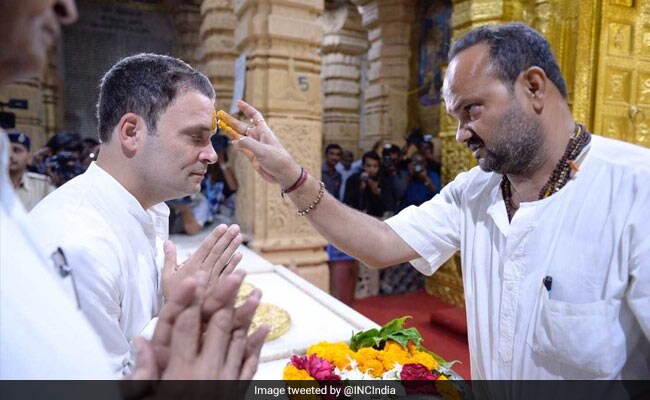
Congress vice president Rahul Gandhi at the Somnath Temple in Gujarat
Ghanshyam says he is a die-hard Hardik Patel supporter and will therefore vote for the Congress. "I joined PAAS (Hardik Patel's outfit) in protest against Narendra Modi's Gujarat model of development which focused on big industry for nearly two decades and failed to create jobs for young people like me." But Ghanshyam says he is not pro-reservation either. "There are too many of us wanting a piece of the same quota pie. All politicians, even Hardik, will have to look beyond it and come up with new ideas. But how will we know what he is capable of unless we give him and Rahul Gandhi a chance?"
Not all of Hardik Patel's young supporters in Varachcha are as reasonable or patient as Ghanshyam. Many have put up hoardings in their neighbourhoods banning the entry of local BJP leaders; a few that dared to cross the line were chased away by angry crowds.
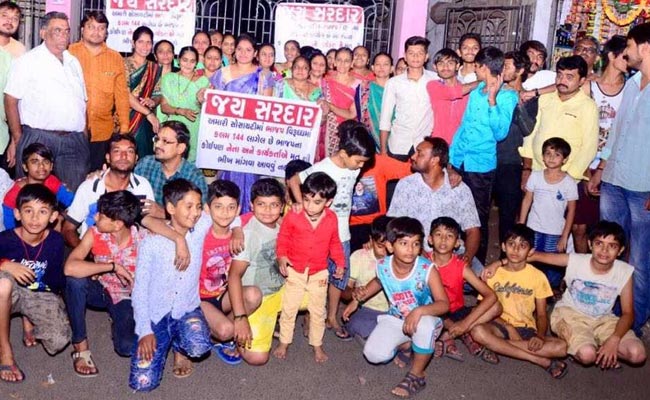
Residents of Patel dominated Varachcha in Surat holding banners that say "BJP leaders are not welcome."
"My information is based on the feedback I am receiving from the call centres set up in each assembly segment," he told NDTV. "Each centre is manned by 50 activists who have been contacting voters over the phone. Anyone who is unavailable has received a house visit. So we have a very good idea of what is happening on the ground." The big picture, he says, is a happy one for the BJP in Surat.
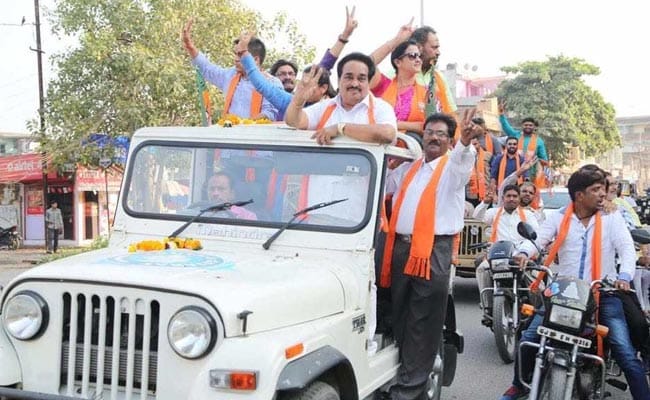
BJP's CR Patil, in-charge of the election campaign in Surat, is confident of the party's victory
These migrants comprise nearly 26% of Surat's 44.26 lakh population and are as frustrated as the Patels by demonetisation and GST. Staunch BJP loyalists, in 2014, they printed thousands of sarees with the slogan "Ab ki baar, Modi Sarkar" and sent them to different cities. The following year, more than a lakh sarees were delivered to Bihar printed with the slogan "Sabka saath, sabka vikaas".
"Our business is down by 60%, and the BJP will pay the price for it," says Tarachand Kasat, who heads the main association of textile traders and has just abandoned the BJP, which he joined in 1982, for the Congress.
It is to placate this constituency of immigrants like him that Uttar Pradesh Chief Minister Yogi Adityanath was sent to Surat, where he is exercising aggressive Hindutva to consolidate the Hindu vote. At one rally, he alleged that Mr Gandhi "sat in the Kashi Vishwanath temple like he was offering namaz." At another, he compared Sardar Patel with Lord Ram who united the entire country.

Uttar Pradesh chief minister Yogi Adityanath has derided the temple visits during Rahul Gandhi's campaign in Gujarat
In the district panchayat elections held after Hardik Patel's 2015 campaign, the BJP won only one of 11 panchayats across Saurashtra. The message had been received from Surat. It is this full-bodied swing at it that the BJP is working overtime to reverse. Hardik Patel may not blow a large hole through the BJP's count in either Surat or Saurashtra. But he is unlikely to be a factor that can be cornered by a defeat.
Track Latest News Live on NDTV.com and get news updates from India and around the world

